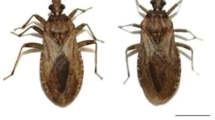Summary
Experiments designed to analyze the lethality and hybridogenesis in the European green frog complex have yielded the following results: 1. As a rule the inter-se cross ofRana esculenta is lethal, but several crosses have produced fully viable progeny. The frequency of such ‘break-through’ crosses appears to be related to parental population structure. 2. Parabiotic joining of lethal to viable embryos indicates that manifestation of the lethal effect is autonomous. There is, however, a 16–18% increase in the life span of the lethal partner. 3. Studies of LDH isozyme patterns revealed that thelessonae-specific alleles coding for the Ba and Bc subunits can be passed to the F1 progeny from a parental female or male of theesculenta phenotype. This demonstrates that there is no total elimination of thelessonae genome in theesculenta germ cells. 4. Immunologically, offspring from the inter-se cross ofR. esculenta show a closer relationship to theridibunda than to theesculenta phenotype. Variations of antigenic protein patterns suggest the possibility of chromosomal recombination betweenlessonae andridibunda in theesculenta hybrid. These results are confirmed by two-dimensional electrophoretic analysis of proteins in the oocytes of the three frog phenotypes.
Similar content being viewed by others
Literatur
Berger, L., Recent progress in the study of the western palearctic water frogs (Amphibia, Ranidae). Experientia38 (1982) in press.
Vogel, P., and Chen, P. S., Genetic control of LDH isozymes in theRana esculenta complex. Experientia32 (1976) 304–307.
Vogel, P., and Chen, P. S., A further study of LDH isozymes in theRana esculenta complex. Experientia33 (1977) 1285–1287.
Berger, L., Egg size as an index of phenotype in progeny ofRana esculenta females. Mitt. zool. Mus. Berl.55 (1979) 187–202.
Günther, R., Untersuchungen der Meiose bei Männchen vonRana ridibunda Pall.,Rana lessonae Cam. und der Bastardform ‘Rana esculenta’ L. (Anura). Biol. Zbl.94 (1975) 277–294.
Berger, L., Some characteristics of the crosses withinRana esculenta complex in postlarval development. Annls zool., Warsz.27 (1970) 373–416.
Vogel, P., Isozyme der Lactatdehydrogenase (LDH) imRana esculenta-Komplex. Ph. D. thesis, University of Zürich, Zürich, Switzerland, 1977.
Tunner, H. G., Das Serumeiweissbild einheimischer Wasserfrösche und der Hybridcharakter vonRana esculenta. Verh. dt. zool. Ges.64 (1970) 352–358.
Tunner, H. G., Das Albumin und andere Bluteiweisse beiRana ridibunda Pallas,Rana lessonae Camerano,Rana esculenta Linné und deren Hybriden, Z. Zool. syst. Evol. Forsch.11 (1973) 219–233.
Vogel, P., Electrophoretische Untersuchungen der Serumproteine von Grünfröschen aus demRana esculenta-Komplex. Diplom thesis, University of Zürich, Zürich, Switzerland, 1973.
Binkert, J. A., Untersuchungen über die Letalität der inter-se-Kreuzung vonRana esculenta. Ph. D. thesis, University of Zürich, Zürich, Switzerland, 1981.
Hamburger, V., A Manual of Experimental Embryology. The University of Chicago Press, Chicago 1942.
Volpe, E. P., The Amphibian Embryo in Transplantation Immunity. Karger, Basel 1980.
Lehmann, F. E., Einführung in die physiologische Embryologie. Birkhäuser, Basel 1945.
George, S. A., and Lennartz, M. R., Methods for determining ploidy in amphibians: Nucleolar number and erythrocyte size. Experientia36 (1980) 687–688.
Uzzell, T., Berger, L., and Günther, R., Diploid and triploid progeny from a diploid female ofRana esculenta (Amphibia, Salientia). Proc. Acad. Nat. Sci. Philadelphia127 (1975) 81–89.
Davis, J. B., Disc electrophoresis II. Method and application to human serum proteins. Ann. N.Y. Acad. Sci.121 (1964) 404–427.
Vesterberg, O., in: Isoelectric Focusing, pp. 78–96. Eds J. P. Arbuthnott and J. A. Beeley. Butterworths, London 1975.
Ouchterlony, Ö., and Nilsson, L. Å., Immunodiffusion and immunoelectrophoresis; in: Handbook of Experimental Immunology, vol. 19, 3rd edn, pp. 1–44. Ed. D. M. Weir. Blackwell Scient. Publ., Oxford and London 1978.
Crowle, A. J., Immunodiffusion. Academic Press, New York 1973.
Bienz, M., Informationelle Suppression beiDrosophila: Entwicklung und Resultate eines in vivo Testsystems, basierend auf derXenopus Oocyte. Ph. D. thesis, University of Zürich, Zürich, Switzerland, 1981.
O'Farrell, P. H., High resolution two-dimensional electrophoresis of proteins. J. biol. Chem.250 (1975) 4007–4027.
Shumway, W., Stages in the normal development ofRana pipiens. Anat. Rec.78 (1940) 139–147.
Berger, L., Sex ratio in the F1 progeny within forms ofRana esculenta complex. Genet. pol.12 (1971) 87–101.
Uzzell, T., Hotz, H., and Berger, L., Genome exclusion in gametogenesis by an inerspecific. J. exp. Zool.214 (1980) 251–259.
Graf, J. D., and Müller, W. P., Experimental gynogenesis provides evidence of hybridogenetic reproduction in theRana esculenta complex. Experientia35 (1979) 1574–1576.
Tunner, H. G., and Heppich, S., Premeiotic genome exclusion during oogenesis in the common edible frog,Rana esculenta. Naturwissenschaften68 (1981) 207–208.
Tunner, H. G., The inheritance of morphology and electrophoretic markers from homozygotic crosses of the hybridogeneticRana esculenta. Mitt. zool. Mus. Berl.55 (1979) 89–109.
Heppich, S., and Tunner, H. G., Chromosomal constitution and C-banding in homozygoticRana esculenta crosses. Mitt. zool. Mus. Berl.55 (1979) 111–114.
Uzzell, T., Günther, R., and Berger, L.,Rana ridibunda andRana esculenta: A leaky hybridogenetic system (Amphibia, Salientia). Proc. Acad. Nat. Sci. Philadelphia128 (1977) 147–171.
Author information
Authors and Affiliations
Additional information
This work was supported by grants from the Swiss National Science Foundation and the Georges and Antoine Claraz Schenkung.
Rights and permissions
About this article
Cite this article
Binkert, J., Borner, P. & Chen, P.S. Rana esculenta complex: An experimental analysis of lethality and hybridogenesis. Experientia 38, 1283–1292 (1982). https://doi.org/10.1007/BF01954915
Published:
Issue Date:
DOI: https://doi.org/10.1007/BF01954915




